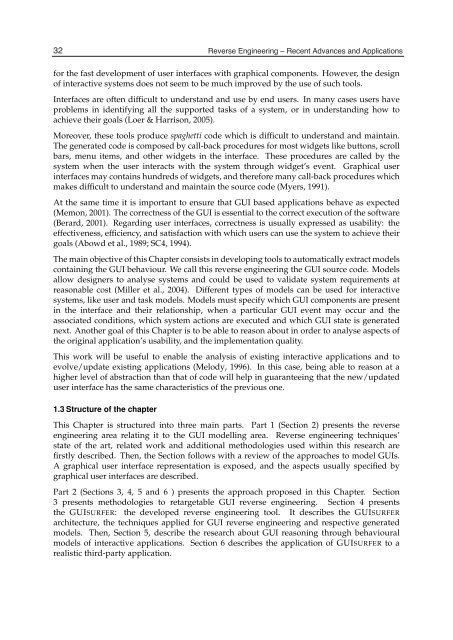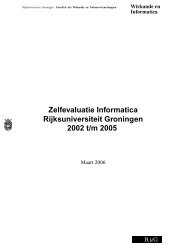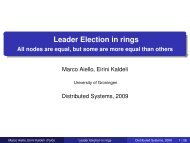Reverse Engineering – Recent Advances and Applications
Reverse Engineering – Recent Advances and Applications
Reverse Engineering – Recent Advances and Applications
Create successful ePaper yourself
Turn your PDF publications into a flip-book with our unique Google optimized e-Paper software.
32 <strong>Reverse</strong> <strong>Engineering</strong> <strong>–</strong> <strong>Recent</strong> <strong>Advances</strong> <strong>and</strong> <strong>Applications</strong><br />
2 Will-be-set-by-IN-TECH<br />
for the fast development of user interfaces with graphical components. However, the design<br />
of interactive systems does not seem to be much improved by the use of such tools.<br />
Interfaces are often difficult to underst<strong>and</strong> <strong>and</strong> use by end users. In many cases users have<br />
problems in identifying all the supported tasks of a system, or in underst<strong>and</strong>ing how to<br />
achieve their goals (Loer & Harrison, 2005).<br />
Moreover, these tools produce spaghetti code which is difficult to underst<strong>and</strong> <strong>and</strong> maintain.<br />
The generated code is composed by call-back procedures for most widgets like buttons, scroll<br />
bars, menu items, <strong>and</strong> other widgets in the interface. These procedures are called by the<br />
system when the user interacts with the system through widget’s event. Graphical user<br />
interfaces may contains hundreds of widgets, <strong>and</strong> therefore many call-back procedures which<br />
makes difficult to underst<strong>and</strong> <strong>and</strong> maintain the source code (Myers, 1991).<br />
At the same time it is important to ensure that GUI based applications behave as expected<br />
(Memon, 2001). The correctness of the GUI is essential to the correct execution of the software<br />
(Berard, 2001). Regarding user interfaces, correctness is usually expressed as usability: the<br />
effectiveness, efficiency, <strong>and</strong> satisfaction with which users can use the system to achieve their<br />
goals (Abowd et al., 1989; SC4, 1994).<br />
The main objective of this Chapter consists in developing tools to automatically extract models<br />
containing the GUI behaviour. We call this reverse engineering the GUI source code. Models<br />
allow designers to analyse systems <strong>and</strong> could be used to validate system requirements at<br />
reasonable cost (Miller et al., 2004). Different types of models can be used for interactive<br />
systems, like user <strong>and</strong> task models. Models must specify which GUI components are present<br />
in the interface <strong>and</strong> their relationship, when a particular GUI event may occur <strong>and</strong> the<br />
associated conditions, which system actions are executed <strong>and</strong> which GUI state is generated<br />
next. Another goal of this Chapter is to be able to reason about in order to analyse aspects of<br />
the original application’s usability, <strong>and</strong> the implementation quality.<br />
This work will be useful to enable the analysis of existing interactive applications <strong>and</strong> to<br />
evolve/update existing applications (Melody, 1996). In this case, being able to reason at a<br />
higher level of abstraction than that of code will help in guaranteeing that the new/updated<br />
user interface has the same characteristics of the previous one.<br />
1.3 Structure of the chapter<br />
This Chapter is structured into three main parts. Part 1 (Section 2) presents the reverse<br />
engineering area relating it to the GUI modelling area. <strong>Reverse</strong> engineering techniques’<br />
state of the art, related work <strong>and</strong> additional methodologies used within this research are<br />
firstly described. Then, the Section follows with a review of the approaches to model GUIs.<br />
A graphical user interface representation is exposed, <strong>and</strong> the aspects usually specified by<br />
graphical user interfaces are described.<br />
Part 2 (Sections 3, 4, 5 <strong>and</strong> 6)presents the approach proposed in this Chapter. Section<br />
3 presents methodologies to retargetable GUI reverse engineering. Section 4 presents<br />
the GUISURFER: the developed reverse engineering tool. It describes the GUISURFER<br />
architecture, the techniques applied for GUI reverse engineering <strong>and</strong> respective generated<br />
models. Then, Section 5, describe the research about GUI reasoning through behavioural<br />
models of interactive applications. Section 6 describes the application of GUISURFER to a<br />
realistic third-party application.




